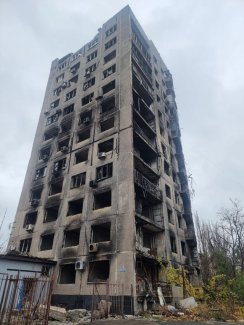Deficiencies of Ukraine’s air defence. 267th day of the war

On 17 November, the Russians launched another missile attack on Ukrainian infrastructure, affecting mainly facilities in the southern part of the country. In total, they were to use 27 cruise missiles and an unspecified number of air-to-ground missiles and kamikaze drones. The Ukrainian air defence reported the downing of four cruise missiles, two air-to-ground missiles and five Shahed-136 drones. In Dnipro, two industrial facilities (including the largest enterprise of the Ukrainian rocket and space industry before the war, Pivdenmash), among others, were hit, and the city was partially deprived of electricity supply. Infrastructure facilities in the Odesa and in Vilniansk areas northeast of Zaporizhzhia were also destroyed or damaged. Near Izyum, gas production infrastructure was attacked, with several facilities destroyed and others damaged.
17 November attack deepened the problems created by earlier Russian missile strikes. On that day, more than 10 million Ukrainians were left without electricity. Due to emergency power cuts in Kyiv, the lowest energy supply was recorded (523 MW against a recent standard consumption of 1000–1200 MW). In addition, the Odesa, Sumy and Vinnytsia oblasts experienced the most significant shortages. Problems with mobile communications were reported in nine oblasts. The smallest number of base stations was in operation in the Odesa Oblast (38%), while in the others, the percentage ranged from 67% (in Mykolaiv) to 82% (in Vinnytsia). Previously lost communications were successfully restored in Kharkiv and Zhytomyr oblasts.
In response to the rocket attacks, President Volodymyr Zelensky admitted on 16 November that he could not call on Ukrainians to return to the country because the air force could not fully protect Ukraine’s skies. He pointed out that about 70% of Russian missiles are currently being destroyed. He stressed that under such conditions, returning from abroad is risky, and the decision must be taken at one’s own risk. The mayor of Ivano-Frankivsk, in turn, appealed to residents to leave the city for the winter if possible due to the risk of power cuts.
Russian artillery and aviation continued to shell and bombard Ukrainian army positions and facilities along the line of contact and in the oblasts bordering the Russian Federation. Kherson and neighbouring Antonivka and Chornobaivka airfield are under the uninterrupted fire control of the aggressor. Russian shelling is consistently destroying the buildings of Nikopol and other nearby villages. Ukrainian artillery and aviation have limited their activity to the main combat areas and Russian hinterland in Zaporizhzhia Oblast. On 17 November, the General Staff of the Ukrainian army reported that defenders had damaged a railway bridge in Chernihivka and that the headquarters of one Russian subunit in Melitopol had been destroyed two days earlier. An act of Ukrainian sabotage allegedly took place in Mariupol, while reports of an attack in the Crimean town of Dzhankoi were not confirmed.
Ukrainian forces are focusing on defending positions in Donbas. Further Russian strikes were to be repulsed in the Bakhmut area, east of Siversk and in an arc west of Donetsk. The Russians were to intensify their assault attempts on the border between Luhansk and Kharkiv oblasts, north-east of Svatove. Ukrainian units were, in turn, to make further attack attempts towards Kreminna. Russian units withdrawn from the Kherson area are to be directed as reinforcements to attacking units in the Donetsk Oblast, while Ukrainian units are to be directed to the borderlands of the Kharkiv and Luhansk oblasts and the Zaporizhzhia Oblast. The British Ministry of Defence confirmed information about the Russian troop movements on 18 November. The Russians are focusing on replenishing manpower shortages and preparing defensive lines along the entire front line in Ukraine and its deep hinterland (in many cases up to 60 km inland), which may indicate preparations to repel a possible Ukrainian offensive.
The head of the US Committee of the Joint Chiefs of Staff, Gen Mark Milley, estimates that 20% of Ukrainian territory is under Russian control. The front line is now 900km long, and the depth of Russian occupation averages 75 to 80 km. Since February, the invaders have committed between 170,000 and 180,000 troops in Ukraine and suffered ‘massive losses’. Still, the mobilisation allowed the Russian army to amass ‘significant combat power’. At the same time, Milley pointed out that the likelihood of Russia achieving its strategic goal of conquering Ukraine was close to zero.
On 16 November, the Verkhovna Rada extended martial law and mobilisation for the fourth time from 24 February – until 19 February 2023. According to the last information on the number of forces defending Ukraine presented by Defence Minister Oleksii Reznikov in July, the figure reached around 1 million due to mobilisation, of which 700,000 are in the Armed Forces of Ukraine. On 17 November, President Zelensky stated that since 24 February, more than 32,000 citizens had been decorated for valour in combat, including 4950 posthumously. The Ukrainian authorities do not disclose the total number of those killed in the war with Russia.
On 16 November, the seventh meeting of countries supporting Ukraine militarily took place in the Ramstein format. Canada has offered a support package of $500 m, Sweden is to donate arms and military equipment worth $287 m, Spain is to donate two additional Hawk system anti-aircraft missile launchers, and Germany is to donate, among other things, ammunition for MARS II multiple rocket launchers, three М1070 Oshkosh tank transport tractors and 24 MG3 machine guns. Greece, in turn, is to hand over a batch of 155 mm ammunition, while Poland is to hand over short-range air defence systems and additional ammunition for artillery and tanks. The day after the meeting, a further tenth support package of €55.6 million was announced by Finland.
The Slovak defence minister announced the transfer of a seventh 155 mm Zuzana 2 self-propelled gun-howitzers to Ukraine. Croatian media reported that its defence ministry had agreed to transfer 14 post-Soviet Mi-8 and Mi-8MTW helicopters to the Ukrainian army, which were due to be withdrawn from service in 2026, but expects them to be replaced by US Black Hawks.
The Czech defence ministry announced that the government has agreed to organise training for 4,000 Ukrainian servicemen on the Czech territory by the end of 2023. It is to take place in five shifts of 800 soldiers each. The training is to be integrated into an EU training mission, where the Czech Republic will provide 55 instructors. The cost of the training has been estimated at NOK 195 million until the end of 2022 and NOK 780 million the following year. The Czech Ministry of Defence budget and EU funds will finance it.
The Ukrainian side, influenced by information from Poland and the US, began to correct its position regarding the missile explosion in Przewodów. On 16 November, President Zelensky claimed that the rocket was not Ukrainian. He admitted that he had been in confidential contact with leaders of other countries (including the President of Poland) on this issue. On the evening of the same day, he assured that Ukraine was trying to establish the details of the incident, called for its experts to be included in the ongoing investigation and for access to the site and data available to Western partners. On 17 November, Zelensky confirmed that Ukrainian experts would take part in the investigation and stressed that until the investigation is completed, it is impossible to say what missiles or parts of missiles fell on Polish territory. He stipulated that he ‘does not know exactly’ what happened, but in his opinion, it was a ‘Russian missile’. He thanked Ukraine’s partners for not blaming it for the tragic incident.
On 17 November, Ukrainian military intelligence (HUR) confirmed that Belarus plans to start production of ammunition for barrel artillery and multiple rocket launchers using production lines obtained from Iran. The Belarusian authorities also plan to start production of 152 mm and 122 mm calibre projectiles and achieve the ability to switch to a closed production cycle for 220 mm and 300 mm ammunition using imported components. According to Hulevich, the Belarusian-Iranian talks are scheduled to take place in Tehran on 20–23 November.
On 17 November, President Recep Tayyip Erdoğan announced the extension of agreements on exporting grain and other food products from the ports of the Odessa complex for another 120 days (the agreements end on 19 November). The decision was taken following Turkish and UN consultations with Russia and Ukraine, which the UN Secretary-General confirmed. Erdoğan also discussed grain supplies to African countries with Vladimir Putin. The Russian Foreign Ministry issued a communiqué stating that it had no objection to the extension of the agreement. At the same time, it stressed that the authorisation of agricultural exports from Ukraine is linked to the fulfilment of the memorandum between Russia and the UN on the normalisation of export conditions for Russian grain and mineral fertilisers. Moscow is seeking the resumption of Russian ammonia exports through the Odesa port. Kyiv is demanding expanding the list of goods and ports (including Mykolaiv) that can use the grain corridor.
Commentary
- Reports of enemy missile shoot-downs by the Ukrainian army indicate that its air defence capabilities are far from sufficient to cover all operation theatres. Declared successes in the Kyiv area (18 out of 21 enemy cruise missiles were to be shot down there on 15 November) may indicate that the bulk of modern missile systems received from the West has been accumulated around the capital. Reports from the oblasts where the fighting is taking place and those immediately adjacent to them are no longer favourable for Ukrainian air defence. In the 17 November attacks, targeting Kharkiv, Dnipropetrovsk, Zaporizhzhia and Odesa oblasts, the defenders were said to have shot down less than 15% of enemy cruise missiles (4 out of 27).
- Ramstein-7 showed the most ‘modest’ results among such encounters conducted in this format. Apart from reports of further deliveries from Greece and Poland, it brought no new information regarding military support to the Ukrainian army. Packages from Canada, Germany and Sweden were already known. When juxtaposed with Kyiv’s demands, and above all in the context of the recent Russian missile attacks, they are highly unsatisfactory for the Ukrainian side. The Ukrainians demanded an acceleration and increased deliveries of NASAMS systems and the start of deliveries of Patriot systems and fighter aircraft (US F-15s and F-16s were mentioned). In the meantime, token deliveries of non-latest anti-aircraft missile systems from Spain and Sweden and – probably the largest, but involving only short-range weapons – from Poland were reported. Single batteries of IRIS-T and NASAMS systems have arrived in Ukraine, representing a fourth of the promised German and US armaments of these types, respectively, most of which are not due to arrive until 2023. Kyiv should still receive a few launchers of older types by the end of the year (most – four Hawk systems – from Spain). This is obviously not enough for the country to counter Russian missile attacks effectively.





